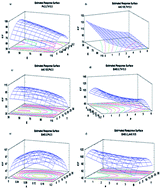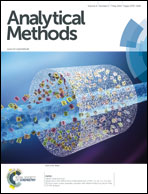Application of multi-factorial experimental design to successfully model and optimize inorganic arsenic speciation in environmental water samples by ultrasound assisted emulsification of solidified floating organic drop microextraction
Abstract
Ultrasound assisted emulsification of solidified floating organic drop microextraction (USAE-SFODME), combined with electrothermal atomic absorption spectrometry (ETAAS), was developed for the preconcentration and determination of trace amounts of As(III) and As(V) in environmental water samples. At pH = 1, As(III) formed complexes with ammonium pyrrolidine dithiocarbamate (APDC) and these were extracted into the fine droplets of 1-dodecanol (extraction solvent) which were dispersed with the aid of ultrasonication into the water sample solution. After extraction, the organic phase was separated by centrifugation, and was solidified by transferring into an ice bath. The solidified solvent was transferred to a vial and melted quickly at room temperature. As(III) was determined in the melted organic phase while As(V) remained in the aqueous layer. Total inorganic As was determined after the reduction of the pentavalent forms of arsenic with sodium thiosulphate and potassium iodide. The concentration of As(V) was calculated as the difference between the concentrations of total inorganic As and As(III). The variables of interest in the USAE-SFODME method, such as the volume of extraction solvent, pH, concentration of APDC (chelating agent), sonication time and salt effect were optimized using multivariate optimization approaches. A fractional factorial design (FFD) for screening and a central composite design for optimizing the significant variables were applied. A mathematical model was presented that successfully predicts changes in the response, depending on the input variables. Under the optimum conditions, the proposed method has been successfully used for the determination of inorganic arsenic in different environmental water samples and certified reference material (NIST RSM 1643e).


 Please wait while we load your content...
Please wait while we load your content...